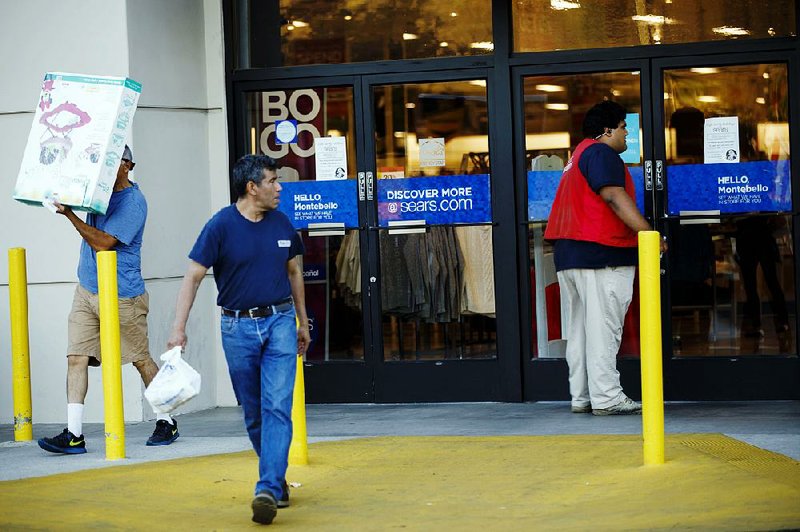The bankrupt estate of Sears Holdings Corp. sued former Chairman Eddie Lampert and his hedge fund ESL Investments Inc., claiming they wrongly transferred $2 billion of company assets beyond the reach of creditors in the years leading up to the retailer's bankruptcy.
"Had defendants not taken these improper and illegal actions, Sears would have had billions of dollars more to pay its third-party creditors today and would not have endured the amount of disruption, expense, and job losses resulting from its recent bankruptcy," lawyers for the estate said in a court filing.
The lawsuit was filed by the team winding down what remains of Sears' business after Lampert purchased the majority of its remaining assets in a bankruptcy auction earlier this year. The complaint, filed in the U.S. Bankruptcy Court in New York late Wednesday, seeks to recover the property that was allegedly fraudulently transferred.
The complaint, filed as part of the retailer's ongoing bankruptcy case, asks that the transactions be ruled fraudulent transfers and says creditors should be compensated.
ESL said it "vigorously" disputes the claims and calls them "baseless" and "fanciful" in a statement emailed to The Associated Press.
The 110-page lawsuit cited sales or spinoffs of key assets it says were used to line Lampert's own pockets and that of his hedge fund.
Other defendants who allegedly benefited from the transfers include Fairholme Capital Management LLC, Seritage Growth Properties Inc. and U.S. Treasury Secretary Steven Mnuchin, whom the complaint says was an investor and former vice chairman at ESL.
Lampert has previously cited multiple deals he engineered to keep Sears in business and said that all his actions had the best interests of the company in mind.
"The debtors' allegations are misleading or just flat wrong," ESL said, adding that Sears received proceeds of more than $3 billion from the transactions, all of which were applied to reduce debt and fund operations.
"ESL was a constant source of financing for Sears Holdings for many years," it said.
Lampert, who merged Sears and Kmart in 2005, steered Sears into Chapter 11 bankruptcy protection in October. The company came within hours of liquidation. Lampert emerged in control of Sears with a last-minute rescue offer, but the squabbling over assets between ESL and the estate continued even after the deal was sealed.
The company's corporate parent had 687 stores and 68,000 employees at the time of the bankruptcy filing. At its peak in 2012, its stores numbered 4,000. The approval of Lampert's new business means roughly 425 stores and 45,000 jobs will be preserved.
As part of the bankruptcy agreement, the "new Sears" was protected from lawsuits, making it unlikely the revived operating company will directly face any of the claims made in the complaint.
"It's obviously a liability for Eddie himself," said Noel Hebert, a credit analyst who covers Sears for Bloomberg Intelligence. "The reality is, he's going to be stuck in litigation. There's enough here that the risk is he's going to have to settle or be doing this for a long time."
The complaint highlights five transactions that it says unfairly benefited Lampert and the defendants that involved Orchard Supply Hardware Stores Corp., Sears Hometown and Outlet Stores Inc., Sears Canada Inc., Lands' End Inc. and Seritage.
Lawyers for the estate also allege that ESL stripped Sears of the real estate under 266 of the retailer's most profitable stores, undervaluing the land by at least $649 million. "Moreover, the culpable insiders arranged for Sears to lease the properties back under blatantly unfair terms," according to the complaint.
Sears has been insolvent since at least 2014, which means Lampert and the other defendants had a duty to protect creditors, not just themselves and other equity holders, the estate asserted.
Unsecured creditors, who rank at the bottom of the list to be paid, objected to Sears' sale to Lampert, alleging falsified financial projections, excessive buybacks, and a spinoff of brands that stripped the business of key assets in a 100-plus page document filed in late January. It chronicled what it called a "tortured story of Sears." That served as a preview of Wednesday's lawsuit.
Before the sale, Lampert personally owned 31 percent of Sears' outstanding stock, and his hedge fund has an 18.5 percent stake, according to FactSet. He stepped down as chief executive officer in October after serving in that role since 2013.
Information for this article was contributed by Josh Saul and Steven Church Bloomberg News, by Anne D'Innocenzio of The Associated Press and by Lauren Zumbach of the Chicago Tribune.
Business on 04/19/2019
